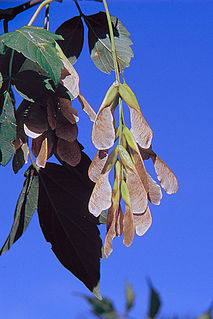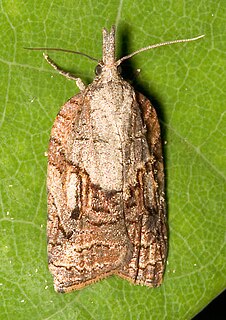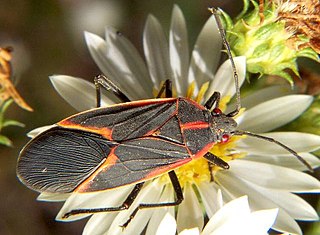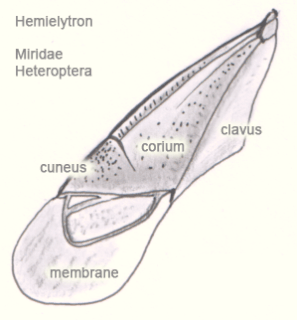Stink bug or stinkbug is a common name for several insects and may refer to:

Pentatomidae are a family of insects belonging to the order Hemiptera, which are generally called stink bugs or shield bugs. The name Pentatomidae is from the Greek pente meaning five and tomos meaning section, which refers to the five segments of their antennae.

Acer negundo is a species of maple native to North America. Box elder, boxelder maple, ash-leaved maple, and maple ash are among its common names in the United States; in Canada it is commonly known as Manitoba maple and occasionally as elf maple; in the United Kingdom and Ireland it is known as ashleaf maple.
Box Elder or Boxelder may refer to:
Serinethinae is a subfamily of the hemipteran family Rhopalidae, sometimes known as soapberry bugs. They are brightly colored seed-eaters, comprising three genera and about sixty-five species. These bugs are specialists on plants in the soapberry family (Sapindaceae), which includes maples, balloon vines, and soapberry trees, among others. Seeds of the plants are the main resource used by adults for reproduction and nymphs for growth and development. Their diversity is the result of an adaptive radiation on these plants, whose cyanide-based defenses the bugs have overcome. The New World genus Jadera consists of nearly 20 species that range naturally from Kansas to southern Argentina. Boisea consists of 4 species, 1 in Africa, 1 in India, and 2 in North America, including the well-known box elder bug, Boisea trivittata. Leptocoris includes more than 40 species, in Oceania, Australia, Asia, and Africa.

Rhopalidae, or scentless plant bugs, are a family of true bugs. In older literature, the family is sometimes called "Corizidae". They differ from the related coreids in lacking well-developed scent glands. They are usually light-colored and smaller than the coreids. Some are very similar to the orsilline lygaeids, but can be distinguished by the numerous veins in the membrane of the hemelytra. They live principally on weeds, but a few are arboreal. All are plant feeders. The type genus for the family is: Rhopalus. Currently 18 genera and over 200 species of rhopalids are known. The oldest fossil rhopalids described are from the Middle Jurassic of Inner Mongolia, discovered from the Haifanggou Formation.
HMS Precise (Z285) was a net laying ship for the Royal Navy during the Second World War acquired from the United States Navy in December 1944 via Lend-Lease.

The tufted apple bud moth is a moth of the Tortricidae family. It is found in eastern North America, from Ontario, south to Florida, west to Oklahoma.
Wyoming Highway 90 (WYO 90) is a 3.00-mile (4.8 km) long north-south Wyoming state highway located in western Converse County southeast of Glenrock. The highway is locally known as Boxelder Road.

Proteoteras aesculana, the maple twig borer, early proteoteras or maple tip moth, is a moth of the Tortricidae family. It is found from coast to coast in the northern United States, south to Mississippi in the east and to California in the west. It has a scattered distribution in Canada, from Nova Scotia to southern Alberta.
The red-lined blind snake is a species of snake in the family Leptotyphlopidae.

The boxelder leafroller is a moth of the family Gracillariidae. It is known from Quebec, Canada, and Colorado, Kentucky, New York, California, Maine, Ohio and Vermont in the United States.

Boisea is the least speciose genus of the soapberry bug subfamily. Members of this genus are found in North America, India, and Africa. Unlike other serinethine genera, the distribution of Boisea is very patchy; it is speculated that its highly vicariant range is relictual of what was previously a much vaster, continuous range. The most well-known species of this genus are the North American boxelder bugs and African Boisea fulcrata. The US species mainly feed on the seeds of Maple trees and are occasional nuisance pests around homes.
Leptocoris is the largest genus of the soapberry bug subfamily. The 41 species of this genus are distributed throughout Africa, South Asia, and Oceania and are thought to have originated in Africa, where the greatest diversity of Leptocoris species are found. Members of this genus are large-bodied and have short, wide pronota; they are similar in appearance to the New World genus Jadera. Leptocoris species can be easily distinguished from the small, slender Boisea. The Australian Leptocoris tagalicus has been studied for its ability to rapidly adapt to invasive hosts and is seen as a possible means of biocontrol for environmental weeds. The southeast Asian species Leptocoris vicinus is common in urban settings, although it is frequently misidentified as Leptocoris augur.

Coryphellina rubrolineata is a species of sea slug, an aeolid nudibranch, a marine heterobranch mollusc in the family Flabellinidae.

Boxelder Creek is a stream in Pennington, Meade and Lawrence counties, South Dakota, in the United States. It is a tributary of the Cheyenne River.
Contarinia negundinis, known generally as boxelder gall midge, is a species of gall midges in the family Cecidomyiidae. Other common names include the boxelder bud gall midge and boxelder leaf gall midge.
Microrhopala rubrolineata is a species of leaf beetle in the family Chrysomelidae. It is found in Central America and North America.












